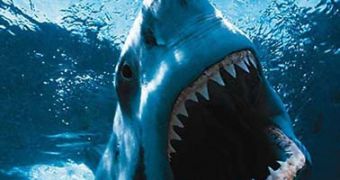With a strong rocket-like body, up to 7.2 m (24 ft) long and up to 3.4 tons heavy, the white shark hunts from fish (including other sharks) to seals and dolphins.
They can suddenly attack swimmers, surfers or boats, sinking them, but humans do not seem to represent their favorite dish. They bite once and release the victim, inflicting deep wounds without any tear. This is a complex hunting method: if the prey is not killed by this first attack/bite, the shark lets it escape to the surface just to inflict a second attack when the victim is already debilitated by the massive bleeding.
This first bite also allows the shark to taste its victim. The white shark prefers fat preys, like seals, that provide the huge amount of energy required by its active lifestyle in cold waters. Human flesh is not fatty, that's why most white shark attacks end after the fist bite.
Now researchers are building a 3D computer model to check the 'bite force' of the Great White shark employing information from a 2.4 m (8 ft) long, 5 years old individual caught in beach nets off Australia's NSW Central Coast, based on the analysis of the jaw and facial muscles.
The project led by Dr Stephen Wroe is a collaboration between NSW DPI, the Universities of NSW, Newcastle and Tampa, Florida, and aims to find the cranial mechanics and bite force of the dreaded beast.
Underwater tests with live sharks do not adequately indicate the peak force of the Great White's bite, and the sharks have been observed to bite through materials that require much higher force than that which has been tested so far. "Sharks generally test bite before applying a full-force bite. The test bite has much less force", said NSW DPI shark scientist Denis Reid.
This approach will use mathematical and computing methods that were originally developed for the measurement of stresses in structures like bridges to see the maximum force that the Great White can exert.
Sharks like the Great White could be responsible for harming submarine cables and communication systems on US Navy submarines. "One of the project aims is to identify the shark species responsible for damage to submarine cables and towed arrays. Measurement of bite forces will help in testing and developing materials suitable for cabling and sensory equipment used in the marine environment.", said co-author Dr Michael Lowry of the NSW DPI.

 14 DAY TRIAL //
14 DAY TRIAL //